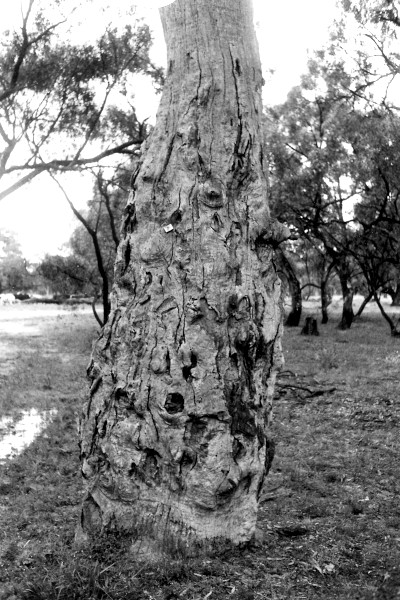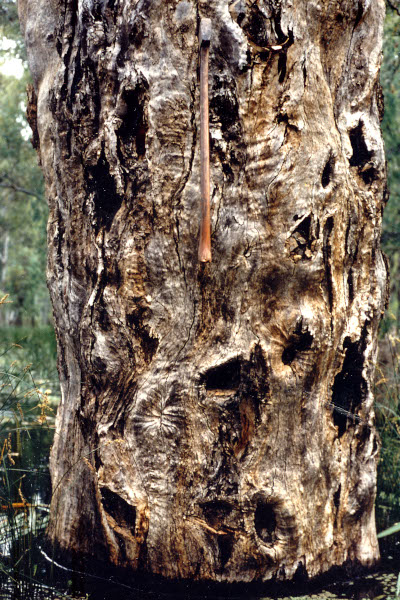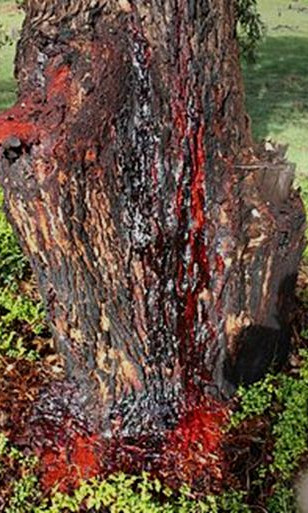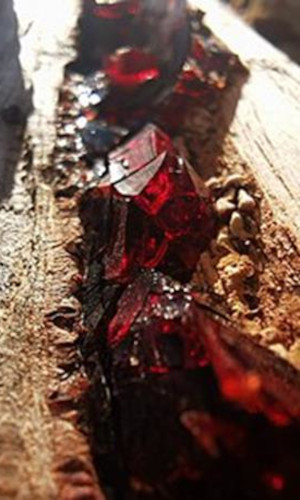Kino
M McKinty
One of the more unusual minor products from Victoria’s forests, kino was a sufficiently common extractive material for the Victorian State Forests Department to list it as a source of revenue in its Annual Reports between 1909 and 1914.
The bark of the River Red Gum when injured exudes an abundance of kino.1 The scars on the River Red Gums near Cohuna (shown below) are the result of them being ‘tapped’ for kino.

Kino tree at Spence's Bridge, Cohuna
1975
Source: FCRPA

Kino tree at Yarran Creek, Cohuna
1975
Source: FCRPA
Kino is a botanical gum produced by various trees and other plants, particularly bloodwood species of eucalypts (Angophora, Corymbia, Eucalyptus) and Pterocarpus, in reaction to mechanical damage.4 Many eucalypts are commonly referred to as 'bloodwoods' as the kino usually oozes out with a very dark red colour. Kino flow in angiosperms contrasts with resin flow in conifers.4 The word ‘kino’ is of Indian origin and, in Australia, ‘red gum’ is a term for kino from bloodwood trees and the red acaroid resin from Xanthorrhoea spp.4
Composition
When exuding from a tree, kino resembles red-currant jelly, but hardens in a few hours after exposure to the air and sun. It typically dries to an amber-like material consisting of dark red angular fragments that are rarely larger than a pea. The smaller fragments are reddish, the larger are almost black and thin pieces are ruby red. It is brittle and easily powdered. It has no smell, but a very astringent taste because astringent tannin compounds are a major active component. The chief constituent (70%-80%) is kinotannic acid. In cold water it is only partially dissolved, leaving a pale flocculent residue which is soluble in boiling water but deposited again upon cooling. It is soluble in alcohol and caustic alkalis.4
Kino Sources
“Many trees yield their kino in a viscid state on tapping a gum vein in spring or autumn. Exposure to the air usually hardens it almost immediately. As a very general rule, the kinos are collected naturally exuded and hardened on the outside of the bark... Some of them are used by the settlers for ink and for staining leather black, the process simply consisting in boiling the kino in an iron saucepan.” (Maiden in Low 3)
More than 30 eucalypt kinos were tested in Maiden’s time, and one from the River Red Gum remained in the British Pharmacopoeia until at least 1949.3
Kino and other tannins are produced by plants as a defensive mechanism. When a caterpillar bites into a tannin-rich leaf, the liberated tannins react with the enzymes in the insect’s saliva and the proteins in the leaf, rendering the leaf indigestible. Tannins in bark and kino provide a similar kind of protection against insect borers, fungi and bacteria.3
‘Gum veins’, composed of kino ducts, form when the cambial layer of eucalypts is injured, particularly by fire but also by insects and mechanical damage, and also around knots.2 They are a cause of degrade in many Australian timbers.
Kino can be tapped by incisions made in the tree trunk.
"During experiments ... attempts were made to stimulate gum veins to an extent which would enable commercial production of kino. Flagellation of the trunk with a suitable instrument induces a large number of injuries. Kino production in these injuries can be further stimulated by a grease covering. It would be possible to grow a tree which had a high percentage of kino in it, but a considerable amount of work would be involved in the process." 2
Kino obtained from the West African Pterocarpus erinaceus was introduced to European medicine in 1757. In the early 20th Century, the drug recognized as the legitimate kind was East Indian, Malabar or Amboyna kino which is the evaporated juice obtained from incisions in the trunk of Pterocarpus marsupium. In addition to kinos from these two species, Bengal or Butea kino from Butea frondosa and Australian, Botany Bay, or Eucalyptus kino from Eucalyptus siderophloia and Eucalyptus camaldulensis, were imported into the United States and Britain.4

Kino from a wound on the trunk of a marri (Corymbia calophylla)
Source: Wikipedia.

Kino solidified inside damaged eucalypt log
Source: Wikipedia.
Applications
Astringent tannin compounds are a major active component of kinos.4
Tannin-rich plants have been used for thousands of years throughout the world to treat dysentery, sores and inflamed throats and gums. Tannin-rich Australian plants, with eucalypts having the highest levels, were used in a large number of Aboriginal and colonial remedies, particularly for diarrhoea, throat and gum ailments, burns, abrasions and to staunch bleeding. Tannin from kino was also used in tanning and in dyes.
The extraordinary versatility of tannins as medicines is due to their reaction with proteins to form an inert layer. They are described as astringent – referring to the tightening effect of tannins on internal body membranes. A drink of a strong tannin solution can form a surface lining on the intestine for the treatment of diarrhoea resulting from irritation of the intestine. By bonding with the proteins of damaged surface cells of a burn or abrasion, the tannins form a tight protective layer, which limits contamination and loss of serum. And, by reacting with the dead proteins, they neutralise a potential source of food for harmful bacteria.3
A medicinal tincture of kino which contained kino, glycerin, alcohol, and water was used as a gargle. It ceased being used when antiseptics became recognized as the rational treatment for a sore throat.4
While kino and other medicines derived from Australian plants during the colonial era were sold overseas for a time, few were commercially successful.
References
1 Ewart, A.J. Handbook of Forest Trees for Victorian Foresters. Forests Commission of Victoria, Melbourne, 1925.
2 Jacobs, M.R. Growth Habits of the Eucalypts. Forestry and Timber Bureau, Government Printer, Canberra, 1955.
3 Low, Tim. Bush Medicine (A Pharmacopoeia of Natural Remedies). Angus & Robertson, Australia, 1990.
4 Wikipedia.
